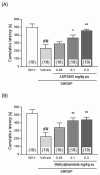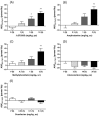The KCNH3 inhibitor ASP2905 shows potential in the treatment of attention deficit/hyperactivity disorder
- PMID: 30462746
- PMCID: PMC6248980
- DOI: 10.1371/journal.pone.0207750
The KCNH3 inhibitor ASP2905 shows potential in the treatment of attention deficit/hyperactivity disorder
Abstract
N-(4-fluorophenyl)-N'-phenyl-N"-(pyrimidin-2-ylmethyl)-1,3,5-triazine-2,4,6-triamine [ASP2905] is a potent and selective inhibitor of the potassium voltage-gated channel subfamily H member 3 (KCNH3) that was originally identified in our laboratory. KCNH3 is concentrated in the forebrain, and its overexpression in mice leads to cognitive deficits. In contrast, Kcnh3 knockout mice exhibit enhanced performance in cognitive tasks such as attention. These data suggest that KCNH3 plays important roles in cognition. Here we investigated the neurochemical and neurophysiological profiles of ASP2905 as well as its effects on cognitive function, focusing on attention. ASP2905 (0.0313 and 0.0625 mg/kg, po) improved the latent learning ability of mice, which reflects attention. Microdialysis assays in rats revealed that ASP2905 increased the efflux of dopamine and acetylcholine in the medial prefrontal cortex (0.03, 0.1 mg/kg, po; 0.1, 1 mg/kg, po, respectively). The activities of these neurotransmitters are closely associated with attention. We used a multiple-trial passive avoidance task to investigate the effects of ASP2905 on inattention and impulsivity in juvenile stroke-prone spontaneously hypertensive rats. ASP2905 (0.1 and 0.3 mg/kg, po) significantly prolonged cumulative latency as effectively as methylphenidate (0.1 and 0.3 mg/kg, sc), which is the gold standard for treating ADHD. Further, ASP2905, amphetamine, and methylphenidate significantly increased the alpha-band power of rats, suggesting that ASP2905 increases arousal, which is a pharmacologically important activity for treating ADHD. In contrast, atomoxetine and guanfacine did not significantly affect power. Together, these findings suggest that ASP2905, which acts through a novel mechanism, is as effective for treating ADHD as currently available drugs such as methylphenidate.
Conflict of interest statement
All Authors are employees of Astellas Pharma Inc. This does not alter our adherence to PLOS ONE policies on sharing data and materials.
Figures





Similar articles
-
Neurochemical and neuropharmacological characterization of ASP2905, a novel potent selective inhibitor of the potassium channel KCNH3.Eur J Pharmacol. 2017 Sep 5;810:26-35. doi: 10.1016/j.ejphar.2017.05.045. Epub 2017 May 25. Eur J Pharmacol. 2017. PMID: 28552344
-
ASP2905, a specific inhibitor of the potassium channel Kv12.2 encoded by the Kcnh3 gene, is psychoactive in mice.Behav Brain Res. 2020 Jan 27;378:112315. doi: 10.1016/j.bbr.2019.112315. Epub 2019 Oct 22. Behav Brain Res. 2020. PMID: 31654662
-
Improvement of learning and increase in dopamine level in the frontal cortex by methylphenidate in mice lacking dopamine transporter.Curr Mol Med. 2015;15(3):245-52. doi: 10.2174/1566524015666150330144018. Curr Mol Med. 2015. PMID: 25817856 Free PMC article.
-
A review of the pathophysiology, etiology, and treatment of attention-deficit hyperactivity disorder (ADHD).Ann Pharmacother. 2014 Feb;48(2):209-25. doi: 10.1177/1060028013510699. Epub 2013 Nov 1. Ann Pharmacother. 2014. PMID: 24259638 Review.
-
Variables that affect the clinical use and abuse of methylphenidate in the treatment of ADHD.Am J Psychiatry. 2003 Nov;160(11):1909-18. doi: 10.1176/appi.ajp.160.11.1909. Am J Psychiatry. 2003. PMID: 14594733 Review.
Cited by
-
Electrophysiological Brain Changes Associated With Cognitive Improvement in a Pediatric Attention Deficit Hyperactivity Disorder Digital Artificial Intelligence-Driven Intervention: Randomized Controlled Trial.J Med Internet Res. 2021 Nov 26;23(11):e25466. doi: 10.2196/25466. J Med Internet Res. 2021. PMID: 34842533 Free PMC article. Clinical Trial.
-
Small-Molecule Aptamer for Regulating RNA Functions in Mammalian Cells and Animals.J Am Chem Soc. 2023 Apr 12;145(14):7820-7828. doi: 10.1021/jacs.2c12332. Epub 2023 Mar 29. J Am Chem Soc. 2023. PMID: 36991533 Free PMC article.
-
Optimization of Exon-Skipping Riboswitches and Their Applications to Control Mammalian Cell Fate.ACS Synth Biol. 2024 Oct 18;13(10):3246-3255. doi: 10.1021/acssynbio.4c00295. Epub 2024 Sep 24. ACS Synth Biol. 2024. PMID: 39318128 Free PMC article.
-
Designing animal-friendly behavioral tests for neuroscience research: The importance of an ethological approach.Front Behav Neurosci. 2023 Jan 10;16:1090248. doi: 10.3389/fnbeh.2022.1090248. eCollection 2022. Front Behav Neurosci. 2023. PMID: 36703720 Free PMC article. No abstract available.
-
KCNH3 Predicts Poor Prognosis and Promotes Progression in Ovarian Cancer.Onco Targets Ther. 2020 Oct 13;13:10323-10333. doi: 10.2147/OTT.S268055. eCollection 2020. Onco Targets Ther. 2020. PMID: 33116612 Free PMC article.
References
-
- American Psychiatric Association. Diagnostic and statistical manual of mental diseases, fifth edition: DSM-5™ (5th ed.) American Psychiatric Publishing, Washington, DC; 2013
-
- Visser SN, Danielson ML, Bitsko RH, Holbrook JR, Kogan MD, Ghandour RM, et al. Trends in the parent-report of health care provider-diagnosed and medicated attention-deficit/hyperactivity disorder: United States, 2003–2011. J Am Acad Child Adolesc Psychiatry. 2014;53: 34–46. 10.1016/j.jaac.2013.09.001 - DOI - PMC - PubMed
-
- Barkley RA, Fischer M, Edelbrock CS, Smallish L. The adolescent outcome of hyperactive children diagnosed by research criteria: I. An 8-year prospective follow-up study. J Am Acad Child Adolesc Psychiatry. 1990;29: 546–557. 10.1097/00004583-199007000-00007 - DOI - PubMed
-
- Barkley RA, Fischer M, Smallish L, Fletcher K. The persistence of attention-deficit/hyperactivity disorder into young adulthood as a function of reporting source and definition of disorder. J Abnorm Psychol. 2002;111: 279–89 - PubMed
-
- Kutcher S, Aman M, Brooks SJ, Buitelaar J, van Daalen E, Fegert J, et al. International consensus statement on attention- deficit/hyperactivity disorder (ADHD) and disruptive behaviour disorders (DBDs): clinical implications and treatment practice suggestions. Eur Neuropsychopharmacol. 2004;14: 11–28. - PubMed
Publication types
MeSH terms
Substances
LinkOut - more resources
Full Text Sources
Medical

